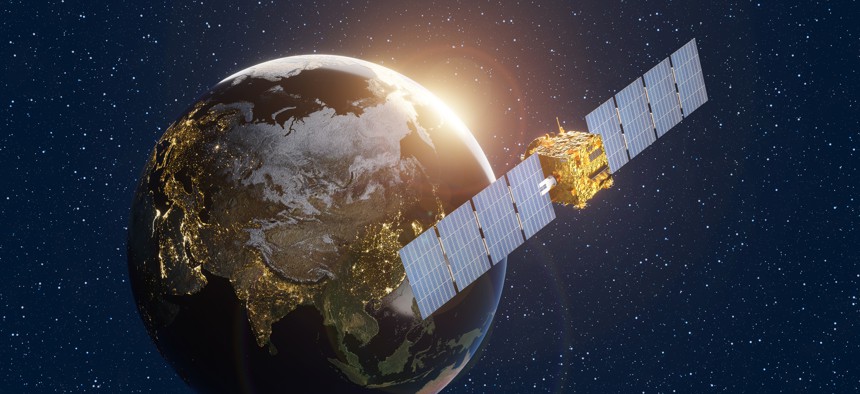Satellite internet can fill broadband gaps

Dragon Claws/Getty Images
As the price of the technology comes down, low-Earth orbit satellites can complement fiber and wireless in helping close the digital divide, experts said.
After years of big promises, broadband internet powered by thousands of low-Earth orbit (LEO) satellites is closer to reality than ever before, according to several experts.
Satellite internet has become cheaper to manufacture and easier to install at customers’ homes and businesses, those experts said, adding that it has grown more reliable and less subject to interference.
Jonathan Cannon, policy counsel for technology and innovation at the R Street Institute think tank, said satellite internet has thus gone beyond the "proof of concept phase."
"This isn't theoretical anymore,” Cannon said during a panel discussion last week at the State of the Net conference in Washington, D.C. “This is real technology going up in space."
LEO satellites generally orbit the Earth at altitudes of 1,200 miles or less, but some of the companies providing satellite internet want to go even lower. Darren Achord, director of public policy for Amazon’s Project Kuiper, said during the conference that the company wants to deploy around 3,200 satellites about 600 kilometers (about 372 miles) above the Earth’s surface.
Achord said deploying satellites at that level lowers latency to the ground receivers, which also helps use spectrum more efficiently. And while the $110 average monthly subscription price for a satellite connection is higher than fiber, he said Amazon is focused on driving down prices, including up front charges for equipment. Competition between providers will also drive down costs, Cannon added.
"Low prices are in our DNA," Achord said, noting that the receiver’s new antenna is a third of the size of the old one. "We know the need is there," he added. Project Kuiper is slated to launch its first two satellites in the next few months.
Satellite internet joins a crowded marketplace for connectivity, alongside fiber, wireless technology and other technologies. But it could play a role connecting people in rural and underserved areas. Even if fiber is still the "best and most efficient way" to connect people in most areas, Cannon said that is not the case everywhere.
Achord agreed and said satellite internet could be a "complement" to other technologies like wireless, especially in areas "where customers are beyond the reach of traditional networks." He said satellite internet may not be necessary in cities and other areas where fiber offerings are already strong. "There's a place for fiber, there's a place for wireless, satellite," he said.
Both Cannon and Achord called for “tech neutrality” from policymakers, which does not show a preference for one method of connectivity above others.
Using satellites for connectivity also excites those in farming, who see them as vital for precision agriculture that helps map fields to guide machinery and rapidly crunch data on soil acidity or water levels. Rep. Glenn Thompson (R-Pa.), who chairs the House Agriculture Committee, said during the INCOMPAS Policy Summit last week in Washington, D.C., that he thinks satellites will be “largely embraced” in the next couple of years in rural areas for those reasons.
Not everyone is convinced by the promise of satellite internet, at least not yet. Last year, in response to the Federal Communications Commission’s release of an initial draft of its new broadband maps, open internet nonprofit Public Knowledge said the draft “misleadingly indicates that the vast majority of the country is served” by satellite. And while the organization’s letter said satellite “in theory, is capable of serving most locations in the country,” in practice, providers cannot do so at broadband speeds.
The confusion prompted SpaceX, another player in the satellite internet market through its Starlink initiative, to write to the FCC earlier this month to clarify how it collected data for the national broadband maps.
In a letter to the FCC, SpaceX Senior Counsel Shea Boyd said the company “crafted its availability data based on the technical capabilities of the Starlink system and a close reading of the rules governing the program.” Boyd said that assumptions about fiber made by the maps’ data collection process “do not apply” to satellite systems, as they are capable of serving a wide geography of users and are only constrained by available capacity, which is driven by local subscription levels.
Federal officials in charge of helping to close the digital divide said the current funding available through the Broadband Equity, Access, and Deployment program is unlikely to repeat itself and that government will need participation from all the different technologies to make sure their efforts bear fruit.
"This is a big moment,” said Alan Davidson, administrator of the National Telecommunications and Information Administration, during an on-stage interview at State of the Net. “We are not going to get tens of billions of dollars to do this again. This is our shot at getting everybody connected, and we need a lot of help."






